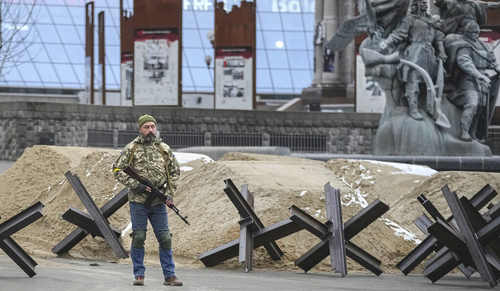
In the early days of Russian President Vladimir Putin’s invasion of Ukraine, colleagues from cultural institutions elsewhere in Europe began reaching out to contemporary art curator Vasyl Cherepanyn, asking whether he was organizing or conceiving new projects in response to the crisis.
Normally such inquiries would be understandable for Cherepanyn, director of the Kyiv-based Visual Culture Research Center, which promotes work that engages art and political activism. But at the moment, he says, art projects are not a top priority for many living in his besieged homeland.
“They just don’t understand what’s really going on,” he said, during a Yale-hosted online event, of these inquiries from well-meaning colleagues. “I’m still keeping hopeful, but I’m doubtful that we will be able to conceive any artistic projects in the near future at all. This is what the war brings.”
This raw expression of frustration and of a future forestalled in Ukraine has been a theme in a series of online conversations launched in early March by the Yale Russian, East European, and Eurasian Studies (REEES) Program at the Yale MacMillan Center just after the start of the invasion. During the series, called “The Humanity Dialogues,” experts from Yale and other academic institutions have been joined by artists, activists, and scholars who are living in Ukraine, or have emigrated or fled, for conversations on the crisis through the lens of arts and the humanities.
For the first conversation, Cherepanyn, the Ukrainian curator, was joined by Timothy Snyder, the Richard C. Levin Professor of History, to discuss tyranny and the agency of artists. For a conversation on cyber resistance, Scott Shapiro, the Charles F. Southmayd Professor of Law and Professor of Philosophy, spoke with Yuliana Shemetovets, a Berarusian activist and spokesperson for the group Cyber Partisans, a pro-democracy group in Belarus, as well as Ivan, a cyber activist from Ukraine (who withheld his last name for security concerns).
During another event, Olga Kopenkina, a Belarus-born curator and art critic, Yulia Krivich, a Ukranian artist living the United States, and Kuba Szreder, a researcher and independent curator at the Academy of Fine Arts in Warsaw, joined Ukrainian curator and anthropologist Asia Tsisar for a discussion about the modes of agency and action that have emerged across artist networks in Central-Eastern Europe as a response to the Russian invasion of Ukraine. In the most recent discussion, William N. Goetzmann, the Edwin J. Beinecke Professor of Finance and Management Studies, Daniel Glaser, a former assistant secretary for terrorist financing and financial crimes for the U.S. Department of the Treasury, and Simon Johnson, a professor of entrepreneurship at MIT Sloan School of Management, examined how the international art market can be used by those funding the war effort to evade financial sanctions, and what can be done to close that loophole.
The structure of the dialogue has allowed us to respond quickly to urgent topics as they have arisen.
Molly Brunson, faculty director of REEES
In the immediate aftermath of Russian assaults on nuclear plants in Zaporizhzhia and Chernobyl, organizers invited Kate Brown, a professor in the history of science at MIT; Oleksiy Radynski, a Ukrainian filmmaker and writer who co-founded the Visual Culture Research Center in Kyiv; and Svitlana Matviyenko, an assistant professor of critical media analysis at Simon Fraser University in British Columbia, to discuss the threat.
During that discussion, the group examined the dangerous and unprecedented implications of military forces targeting nuclear facilities and the threat it poses to the region and far beyond.
As Matviyenko noted, it’s not even clear just how dangerous the situation is since international monitoring is not possible at these plants — and plant operators have to get approval from the Russian military for even minor steps. Yet this weaponization of nuclear plants, she said, is just the latest chapter in a decades-old story of “nuclear colonialism” in Ukraine. The people living near the Chernobyl plant, for instance, faced dire public health threats due to mismanagement of the plant long before the 1986 catastrophe that released enormous amounts of radioactive material into the environment.
And that is just part of a decades-long narrative of exploitation and militarization.
“Part of that story has to do with the imperial and colonial appetites that are so much present in the narrative that we hear from Putin, and all of his pseudo-historical interpretations of the relations between Russia and Ukraine,” Matviyenko said.
The series was organized by Molly Brunson, faculty director of REEES and associate professor of Slavic languages and literatures and the history of art, and Marta Kuzma, professor of art and former dean of Yale School of Art, who felt an urgency to respond after the invasion, to reflect on how war reveals the fragility of humankind and the “contingency of existence,” and to address the interconnectedness of art and politics within societies at war.
Kuzma, who spent the 1990s in Kyiv, where she was founding director of the Soros Center for Contemporary Art, has drawn on her own personal network in creating these events and moderated each of the discussions. Kuzma’s intent had been to address responses from the artistic, academic, and intellectual community within the war-torn Ukraine with solidarity networks across disciplines and countries in an effort to convey the revised role of the artist and cultural producer in such a precarious context.
“We felt like there was a need to bring people together in conversation to address these issues as they came up,” said Brunson. “Also, the structure of the dialogue has allowed us to respond quickly to urgent topics as they have arisen, serving the critical needs of educating the Yale community and the broader public, amplifying voices from Eastern Europe, and encouraging community during such a difficult time.”
For information about future events, and to watch all conversations from the series, visit the Humanity Dialogues website.
By Kevin Dennehy

